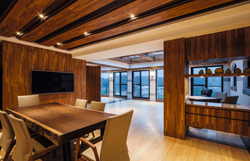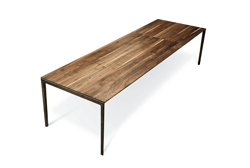Red Dot presents: design trends in the field of interior design and material
Hardly any design field sees as many trends and developments as interior design. The furnishing industry booms, be it furniture, interior decoration or materials. Professional magazines present the latest living ideas and decoration possibilities, and make the topic furnishing available for a broad public. The Red Dot Design Award is regarded as a trend barometer and distinguishes every year the most innovative products with the quality label “Red Dot".
In 2017, haptics, the choice of raw materials and patterns, and the imitation of natural surfaces are the trend. For example, cork is celebrating its comeback. The material is supposed to give warmth into living spaces, among others on side tables or in the form of complete walls. Spanish manufacturer Desenvolupament was awarded with the Red Dot: Best of the Best for “Corktex“ in 2016. It is a versatile covering featuring innovative characteristics, which can be used for decorative walls, ceiling coverings and floors. It is made of high-tenacity polyester thread and a decorative covering with high resistance to abrasion. Its underside features a highly compression-resistant support comprising an agglomerate of cork and rubber granules obtained through a recycling process to ensure ecological soundness and durability.
A preferably natural character is also demanded in the field of wood floors, where colours, shapes and structures can be combined to form a wide variety of optics. Robust and elegant oak is used for the production of the “Edition NEA”, awarded with the Red Dot. Very shallow, round, geometric milled patterns decorate the wood flooring. Relief structures and clear contours create a feature and highlight individual motifs. As the light changes, the look and effect of the flooring is significantly different. The irregular contours and distinctive, discreetly visible patterns in stained black oak make the flooring particularly elegant. “The irregular surface and natural shapes give the Edition NEA wood flooring a very distinctive appearance, which changes depending on the viewing angle”, is what the Red Dot experts said.
What is more and more important in one’s own home are retreats and niches, in order to be able to switch off from the stressful everyday life. At the same time, generous common areas are becoming increasingly popular: Large wooden tables, creating a rustic ambience, offer space to eat, get together and work. As for example the table “tak“, from manufacturer Team 7 Natürlich Wohnen. The wooden table convinced the Red Dot jury with its artisanship with a consciously scaled back appearance and was awarded with the Red Dot in the Red Dot Award: Product Design 2016. The “kayak” chair was able to win over the jury, too, with its traditional form combined with new elements, what created a completely new appearance.
A touch of luxury is also a must. In this context, understatement is very important. It is all about creating rooms with a personal touch. The connection to nature is given by the use of different wood materials and other organic essentials. This has been successfully implemented in the “Villa W” by Ivee Lin, Shawn Lu from the Xjstudio in Taiwan. The villa is modern and minimalist in its design and blends well into its surroundings. The house is reached by way of the garden, whose trees provide an exciting play of light and shadow. The design of the balcony is intentionally open in order to reinforce the proximity to nature. Inside the house, which stretches over several storeys, the obvious natural qualities of the wood and stone create an unpretentious, tranquil atmosphere. The designers of Sunitan Design achieved something similar with the “Natural and Decent Mansion”. The residential house is set in a landscape of lakes, radiates purism and naturalness. The calm colour of the interior picks up on the beauty of nature and thus reflects it. The distinctive design feature of this house is the use of two different types of wood. White oak provides the dominant background of the corridor while walnut inlays, produced with the help of laser technology, provide attention-grabbing eye-catchers. They take the form of trees and exude a forest atmosphere.




